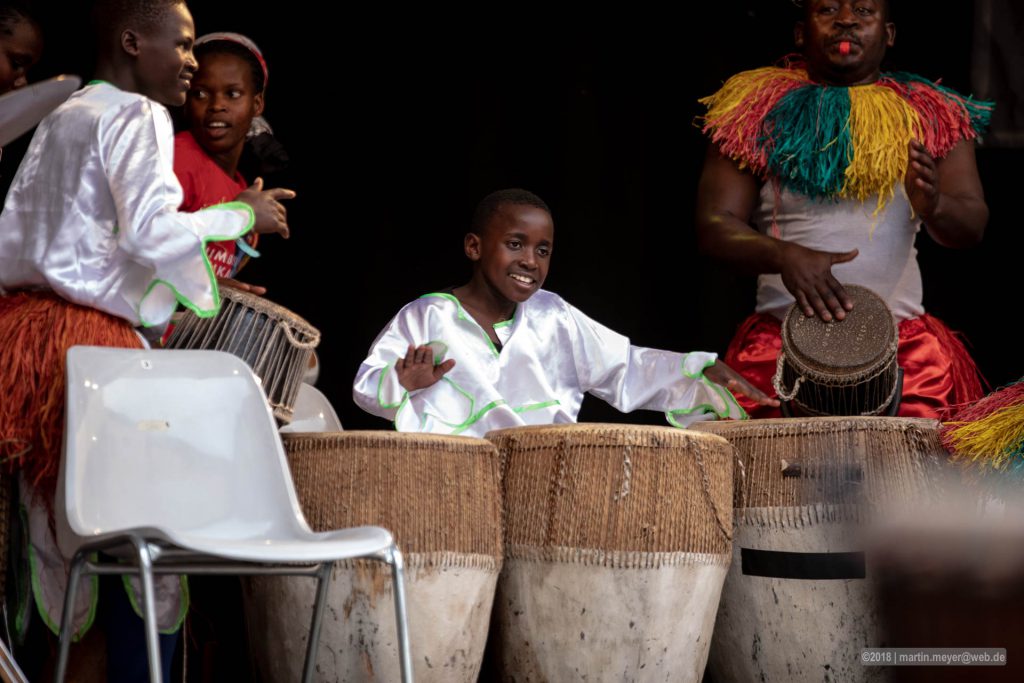Traditional Instruments and Drums
The thrill of the Ugandan music produced by our Traditional Musical Instruments is incomparably unspeakable.
At IMLS, we train most of the musical gadgets or instruments used to produce the richly interesting music that is produced in Uganda.
Some of these musical instruments can be played solo. Some can be played along with others too. However the combination of them all gives you the thrilling sound that makes Africa referred to as the home of Beauty and Uganda the pearl of Africa.
Below are some of these Traditional Instruments that we teach at IMLS:
Engalabi (Long drum)
This percussion instrument is a traditional drum with its head made of reptile skin stretched and nailed to a wooden sound body. It produces sound through vibration of the stretched skin. The Engalabi in Buganda is so important and is used in big ceremonies and in theater acts. It is played using bare hands and may be played along with other shorter drums (Engoma) to produce sweetness of the combined sounds.
Engoma/Drums
As far as music production is concerned, in Africa drums are known as the force that ignites performance. The boost and the rhythm! Since music in the African tradition is not merely about entertainment only, it ultimately avails to visual and dramatic arts as well as the larger fabric of life. Drums may be used for “talking,” that is, sending information and signals by imitating speech. Drumming music and dance are almost always an accompaniment for any manner of ceremony; birth, marriages, funerals. Drums are harbors that Africans are well proud of. Come to IMLS and learn to entertain others or get entertained through the different drums that we have.
Akadongo/Thumb Piano
The Baganda call it “akadongo kabaluru” or “little instrument of the Alur tribe” from the northwest Nile region. In Uganda the instrument is usually played solo, perhaps to relieve a traveler’s solitary trek or a night caretaker’s long watch. The instrument accompanies a repertoire of “songs for thought,” or laments, sung by both men and women.
Endongo/Entongoli/Bowl Lyre/Harp Lute
The term Ndongo refers to the right-string Bowl Lyre of the Baganda, the most commonly known tribe of people living in Uganda.
In the musical tradition of the Baganda, the ndongo is one of the oldest string musical instruments, second only to the ennanga (8-string arched harp). However, a steady decline in use of the ennanga as a folk instrument has been noticed and instead, the Ndongo has gradually replaced it.
Adungu/Enanga/Bow Harp/Arched Harp
This is an eight stringed sweet sound developer. These eight strings are attached inside a wooden built in hollow like semi circled with a wooden cover still on top. In Teso, it is called Adungu, the Baganda call it Ennanga and many others. This is used by several tribes in their cultures like the Alur of Northern Uganda, the Lugbara and Ondrosi in northwestern region around the Nile.
It is used to accompany epic and lyrical songs but can as well be used as a solo instrument. Visit IMLS and learn how to sound this instrument.
Endingidi/Tube Fiddle
It is a one string fiddle best used in the Buganda, Busoga, Ankole, Kigezi, western Nile, and Acholi regions. It consists of a single string, which is attached to a flexible stick and will sometimes have a resonator. Unlike other single-string instruments, it is played with a bow.
Enkwanzi/Panpipe
This wind instrument mostly comes from the Busoga region. It is made from elephant grass or bamboo. They are stopped flutes, meaning that the node of the plant stops the hollow tube and thus determines the pitch of the pipe. The tubes are arranged from lowest to highest and laced together with string. The open rim at the top of each tube is cut at a right angle to the tube so that the player may blow across the top, like blowing across a bottle. This panpipe has at least five pipes. The melodic possibilities of the panpipe and other sets of flutes perhaps influenced the development of flutes with finger holes.
Amadinda/Xylophone
This instrument features two ‘shoulders’ carved into the bottom of the instrument, allowing for the keys to stay fixed when they are placed onto the wooden resonant chamber below. The Amadinda is designed to be played by two musicians simultaneously – both sitting on either side of the instrument and striking the keys with wooden beaters.
Ensaasi/Enseege/Shakers
Shakers are made in pairs from gourds or shells, sometimes with stick handles, and are used to accompany other traditional instruments in Uganda. The central and northern regions have shakers that produce a continuous sound as beads move from side to side in the gourd or shell. Generally, these shakers produce sounds by many small objects, such as pebbles, rattling together inside the body.
Endege
Endege are ankle bells worn around the ankles by able bodied men and women to accentuate their movements. Fabricated from metal, the gear is worn during dances to celebrate the birth of twins, marriage ceremonies, funeral rites and any other cultural event. Dancers frequently have these metal jingles tied on their ankles to articulate their movements.
Ebinyege/Rattles
These originate in Bunyoro and Batooro in Western Uganda along the roots of mountain Rwenzori. The seeds are put in these dry fruits to produce rhythmic patterns when shaken. Ebinyege are tied on the males legs to produce the sound and the Runyege dance (courtship dance of the Batooro) is named after the ebinyege, hence an important prop.
At IMLS, traditional instruments are taught every Friday afternoon from 3:00p.m to 5:00 p.m. Register with us today.

